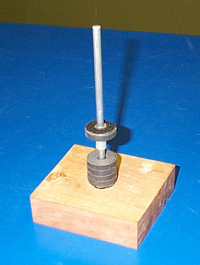![[Virginia Tech Department of Physics]](../images/Mis/vtphyslogo2.gif)
Modern Physics
Q60: Proton-Proton Reaction
![]() Purpose: To simulate the effects of the electrostatic repulsion of protons in the
proton-proton cycle.
Purpose: To simulate the effects of the electrostatic repulsion of protons in the
proton-proton cycle.
|
Lecture Demonstrations | |
Modern Physics |
||
Q60: Proton-Proton Reaction |
||
|
||
|
The electrical repulsion of the protons prevents their coming together close enough for the short-range Yukawa force to be effective, unless the velocity of the protons is quite high-corresponding to about 107 K in stellar interiors. (It would be even higher if quantum tunneling were not present, but that's another demo.) This simulation illustrates that effect, where the repulsive force of the ring magnets mimics the repulsive electric force of the protons and the binding effect of Velcro mimics the short range attractive Yukawa force. The speed of the magnet is derived from gravitational free fall; the speed of the protons is induced by gravitational heating in the star. Put the ring magnets on the stand with the Velcro ends face-to-face. This ensures that like poles face each other and the magnets repel. Lift the upper one from 1 to 3 cm above its equilibrium point and drop it. If you didn't lift it too high, the two magnets won't join. Now lift the upper magnet about 5 cm and drop it. The Velcro ends will join and, if these were protons, a deuteron would result. |
 |
| Storage Location: CHEMP 130A |
| Wooden stand with aluminum post; 2 ring magnets with Velcro strips attached. | D4.4 |
|
Manual: None | Setup Notes: Q60 | PIRA #: |
| Manufacturer(s): | Other school's Demonstration web pages |
![]()